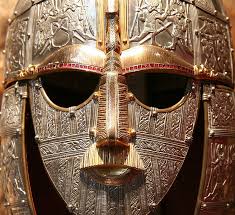By Candice Kettell
There are many myths and stories surrounding the epic poem, Beowulf, but what is really known about its origins? Beowulf is, without a doubt, one of the most important works of English literature. Written sometime between 700 and 1000 AD by an unknown poet, it is an epic heroic story and the oldest surviving poem in the English language. The poem, set in Scandinavia, centers around a hero of the Geats named Beowulf. He slays monsters, dragons, and is nearly indestructible until his fateful end. Of the 30,000 lines of literature left from the Anglo-Saxon period, not only are 4,000 of those lines 4,000 lines preserved in the text of Beowulf, but the epic poem is also a supernatural, incredible record of the history of the time.
Beowulf was written in England sometime between the 8th and 11th centuries, and little is known about the Anglo-Saxon poet, who is primarily known amongst scholars as the “Beowulf poet.” This anonymity is not uncommon, as most poets of this period are unknown. Depending on religious interpretations, it could have been a court poet or a monastic poet (The History behind Beowulf). Although written in England a few centuries later, Beowulf takes place in 6th century Scandinavia. Beowulf’s tribe, the Geats, lived in the southern part of Sweden, while Hrothgar and Heorot were on Sjaelland, an island in Denmark. Some historical digressions take place in other parts of Scandinavia but also Germany, Poland, and areas of Belgium and the Netherlands (The History behind Beowulf).
At the time Beowulf took place, studies show Danish royalty held the throne on Sjaelland Island at Lejre. Many scientists, primarily archaeologists, have discovered magnificent architecture built around the 6th century that could very well have been Heorot. While there is no historical proof the Beowulf was a real person, there is a lot of German context incorporated from the time period and Beowulf. The Ravenswood Battle of 510 AD was real, as were The Geat King, Hygelac, Hrothgar, Ongentheow, Haethcyn, Onela, and Heardred (Lapidge).
Beowulf is an epic poem that is now revered as one of the greatest works of English literature, but at the time it was written, it was considered to be just another monster story. The only remaining manuscript is from around 1000 AD, and stories with supernatural characters and elements were quite common at the time. Apart from Beowulf specifically, the manuscript contains several other texts of medieval origin. The Marvels of the East, the Letter o Alexander to Aristotle, and the Old English poem Judith. The first person to own Beowulf, according to historical records, was Laurence Nowell in the 1500s who was a pioneer of the study of Old English literature. The manuscript then was passed to Sir Robert Cotton who also owned two copies of the Magna Carta, then to Sir Thomas Cotton, then to Sir John Cotton in the 1600s, and finally came to belong to the British Museum in 1753 and then the British Library in 1973 (Beowulf). On the night of October 23, 1731, a fire broke out while the Cotton manuscripts were being held at Ashburnham House at Westminster. Beowulf escaped the fire relatively undamaged, but in the following years, it suffered wear and tear with letters crumbling away from the outer portions of its pages. Eventually placed in frames, the manuscript remains incredibly fragile and can only be handled with extreme care.
The origins of Beowulf, like most works of literature composed during the Anglo-Saxon period, has been widely speculated and debated by scholars and historian alike. Boydell & Brewer have asked, “Where did Beowulf, that unique and thrilling example of an Old English epic poem come from? In whose hall did the poem’s maker first tell the tale? The poem exists now in just one manuscript, but careful study of the literary and historical associations reveals striking details which lead Dr. Newton to claim, as he pieces together the various clues, a specific origin for the poem. Newton suggests that references in Beowulf to the heroes whose names are listed in Anglo-Saxon royal genealogies indicate that such Northern dynastic concerns are most likely to have been fostered in the kingdom of East Anglia. He supports his thesis with evidence drawn from East Anglian archaeology, hagiography, and folklore, bringing life to a vanished age with his sympathetic interpretation of the few records that have survived. His argument, detailed and passionate, offers the exciting possibility that he has discovered the lost origins of the poem in the pre-Viking kingdom of eighth-century East Anglia” (Newton).
Although written during the Anglo-Saxon era, Beowulf continues to captivate modern audiences. The poem has provided inspiration for films, plays, operas, graphic novels and computer games. In recent years, notable versions include “The 13th Warrior” in 1999 which was adapted from Eaters of the Dead by Michael Crichton, the Icelandic-Canadian production “Beowulf & Grendel” in 2005, and “Beowulf” in 2007 starring Anthony Hopkins, Angelina Jolie, and Robin Wright (Beowulf). Translated into many languages, including modern English, Dutch, French, German, Greek, Hungarian, Italian, Japanese, and Russian, the epic poem of Beowulf crosses language barriers as well as cultural boundaries and remains one of the most significant works of literature in all of history.
Works Cited
“Beowulf.” The British Library. Web, 28 Nov 2015. The History behind Beowulf. Pace University. Web, 28 Nov 2015. <projf20004d/History.html>
Lapidge, Michael. The Origins of Beowulf: From Vergil to Wiglaf. Institute of Historical Research. Web,
28 Nov 2015.
Newton, Sam. The Origins of Beowulf and the Pre-Viking Kingdom of East Anglia. Wuffings. Web, 28
Nov 2015. <Beowulf-and-the-previkingkingdom-of-east-anglia>
Image: Viking Mask (Sutton Hoo) via Wikimedia Commons

